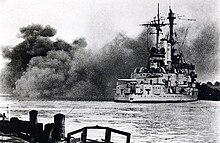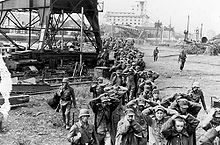Westerplatte
The Westerplatte near Danzig is a largely forested, sandy, elongated peninsula with no significant elevations between the Baltic Sea and the port canal . It became known through the shelling of the Polish ammunition depot on September 1, 1939, which is considered to be the beginning of the Second World War . The Westerplatte memorial, inaugurated in 1966, commemorates the Polish defenders .
Emergence
The Westerplatte was created by sand deposits on the former mouth of the Vistula. The main current of the Vistula , which previously flowed into the Baltic Sea at Danzig , broke on February 1, 1840 about 20 kilometers east of Danzig near the village of Neufähr through the dune belt that separated the low-lying Werder (formerly part of the Frischer Haff ) from the Baltic Sea . As a result, the lower course of the former Vistula became currentless, so that the "Dead Vistula" was created. This was expanded into a port canal through regulation work. On its right bank lies the Westerplatte, which has become a peninsula. It is surrounded in the south by the port canal and in the west and north by the Baltic Sea and in the east at the connection to the land it is about 60 meters wide. Its length is about two kilometers, the greatest width about 600 meters. The port canal is the connection between the port of Gdańsk and the three Gdańsk shipyards at the time to the Baltic Sea. From 1924 to 1939 there was a fortified Polish ammunition store within the boundaries of the Free City of Danzig .
history
Ostseebad Westerplatte
The densely wooded park on the Westerplatte peninsula has been a Baltic seaside resort for hot and cold seaside resorts since around 1830 . The Ostseebad Westerplatte had a spa park with a spa house and sanatorium. The Westerplatte could be reached via Neufahrwasser by tram and ferry or by steamship. In addition to the Bad Westerplatte, the city of Gdansk also had the Baltic seaside resorts of Brösen (today: Brzeźno ) and Heubude (today: Stogi ).
Polish ammunition depot
During the Polish-Soviet War (1919–1921) the dock workers of the Free City of Danzig refused in August 1920, during the Soviet offensive on Warsaw , to unload war material intended for the Polish army . English troops unloaded the ammunition that had arrived on French ships. The Poles blamed the Gdańsk administration for this incident and requested the Free City of Gdańsk to provide a site for an ammunition depot .
The League of Nations granted this demand by resolution of March 14, 1924. Poland was granted the Baltic seaside resort of Westerplatte “as a place to extinguish, store and transport explosives and war equipment”, although the Danzig Senate under Senate President Heinrich Sahm protested against it from the start. At high costs, in which Danzig had to participate unwillingly, a harbor basin was excavated right next to the port entrance at the site of a much-visited seaside resort. For this purpose, appropriate storage sheds were built and a connection to the Gdańsk railway network was created. The Westerplatte did not become Polish territory, but the main part of the peninsula was reserved for the Polish military and not accessible to unauthorized persons. The League of Nations fixed the permissible number of guards at two officers, 20 non-commissioned officers and 66 men. Since an agreement in 1928, the city of Danzig was allowed to maintain two police posts at the entrances to the Westerplatte.
Westerplatte affair
As a result, there were two incidents that made up the "Westerplatte affair". The Treaty of Versailles allowed the Polish side to use the port of Danzig as a “port d'attache / home port” for their warships. However, when a fleet visit by British destroyers took place on June 14, 1932, the Danzig Senate refused the Polish Navy the right to have one of its warships docked there. In response to this, the Polish destroyer ORP "Wicher" ran into the port of Danzig without notifying the Senate as usual. This was followed by mutual courtesy visits between the Polish and British officer corps . In addition, the Westerplatte security team was put on alert. This show of force initially prevented the Senate from further curtailing the rights of the Polish side.
The second part of the "Westerplatte affair" occurred on March 6, 1933, after the Danzig Senate, contrary to the provisions of the contract, had dismissed the port police under the port committee and deployed the Danzig police directly under it to secure the port area surrounding the ammunition depot. In response to this, the Polish troop transport ORP Wilia landed a battalion of Polish marine infantry and thus strengthened the garrison there, contrary to the provisions of the treaty . Marshal Józef Piłsudski wanted to achieve two things with this action: he wanted to make Hitler inclined to hold talks with Poland and, above all, to weaken the ruling German National People's Party , which represented a strong anti-Polish stance and vehemently made revisionist demands. However, the action had an unexpected result for Piłsudski: Since Hitler, underestimated by the Poles, abandoned his plan to install a National Socialist city government in Danzig, the German Nationalists actually opposed by Piłsudski were strengthened.
Expansion of the Westerplatte
In Gdynia ( Gdynia ), which, in contrast to Westerplatte, was located in the Polish Corridor established in 1920 , Poland has meanwhile built its own industrial and military port . This meant that in principle the reasons for the separation of Danzig from Germany or the establishment of the ammunition depot on the Westerplatte had become obsolete, apart from the historical claims asserted by Poland regarding the affiliation of the city to the Prussian Royal Share , which had voluntarily placed itself under the patronage of the Crown of Poland , until the partitions of Poland-Lithuania were established. Due to the political events of 1933 in Germany, Polish marine infantry landed on March 6, 1933 on the Westerplatte to expand the transit camp in Danzig territory with field fortifications. In response to a complaint from Gdańsk, the League of Nations decreed that Poland had to abandon this project and grind down the field fortifications that had been built. The Polish side initially complied with the order. In the years to come, however, it created a fortified defense system by tearing down old buildings and building new accommodation and guard houses with MG positions prepared in the basement. This happened in the period from 1933 to 1936 under the direction of Major (Ing.) Mieczysław Kruszewski, the head of the naval fortification department.
After the German occupation of the "rest of the Czech Republic" , the fortifications were reinforced in March 1939. The armament was a 7.62 cm field gun, two 3.7 cm anti-tank guns, 18 heavy and 23 light machine guns, as well as rifles, pistols and hand grenades . The combat mission for the crew was to hold the position for twelve hours in the event of a German attack.
Outbreak of war in 1939
German preparation
The first plans for the invasion of Poland saw the August 26, 1939 as a deadline before. On August 25, 1939, the Schleswig-Holstein liner, serving as a training ship, entered the Danzig harbor canal on an alleged visit. The intention was to shoot the Polish garrison ready for assault with their heavy ship guns of 28 cm and 10.5 cm caliber when the war began. The conquest itself was to be carried out by a naval shock troop company (MSK) with four officers, a doctor and 225 men secretly on board .
Attack on September 1, 1939
On August 31, the encrypted radio message came with the request to attack Poland at 4:45 a.m. the next day. On the night of September 1, the "Schleswig-Holstein" was relocated in the port canal in order to have a better field of fire on the Westerplatte. Supported by the SS Heimwehr Danzig , the MSK soldiers attacked from the land side.
The first attack remained in defensive fire with heavy German losses. After the defenders were able to repel the attacks on the second day of the war, bombing attacks were requested, which were carried out on September 2 by Stuka associations. Due to the lack of coordination between the German associations, however, a subsequent infantry attack failed to materialize. The shelling and bombardment of the Westerplatte dragged on until September 7th, when an unsuccessful armed reconnaissance took place. It was only after the defenders had halted this advance that they capitulated. German officers saluted the withdrawing Polish soldiers, the commandant, Major Henryk Sucharski , was given back the saber "with the right to wear it during captivity".
The Polish losses were relatively small in view of the heavy fire from 28 cm and 10.5 cm ship guns and the attack by aircraft: a Polish source puts them at 15 dead, 13 seriously and 25 to 40 lightly wounded. The number of German soldiers tied up during the week-long attack on Westerplatte is estimated at 3,400. Polish films about the events of 1939 were made in 1967, 1988 and 2013.
After the fighting, a branch of the Stutthof concentration camp was set up. The prisoners, among them Polish priests, had to clean up.
Westerplatte today

This defense became a symbol of resistance against Germany in Poland after the war. The monument was created in 1966. The Westerplatte has kept its German name in Poland.
Another memorial decorated with flowers commemorates 15 Polish defenders, most of whom died on September 2nd. The destroyed three-storey "barracks" can be entered and was secured against further deterioration by concrete arches. Three groups of large display boards commemorate the events of 1939 and the surrender of Westerplatte on September 7th.
In August 2007, a memorial with a Soviet T-34 tank was removed as it had nothing to do with the events of 1939 on the Westerplatte. Two parts of a T-34 tower can still be seen as relics on the embankment, the lettering has been removed.
literature
- William K. von Uhlenhorst-Ziechmann: Westerplatte. 1939. A play in three acts. Exposition Press, New York NY 1955.
- Bertil Stjernfelt, Klaus-Richard Böhme: Westerplatte 1939. Rombach, Freiburg 1978, ISBN 3-7930-0182-2 .
Web links
See also
Individual evidence
- ^ Marian Wojciechowski : The Polish-German Relations 1933–1938. Translation Norbert Damerau, Brill (Verlag) , Leiden 1971, p. 10 f.
- ↑ Z. Flisowski: Westerplatte, Zebral, opracowal i wstepem opatrzyl. 7th edition. Warsaw 1974.
Coordinates: 54 ° 24 ' N , 18 ° 40' E






